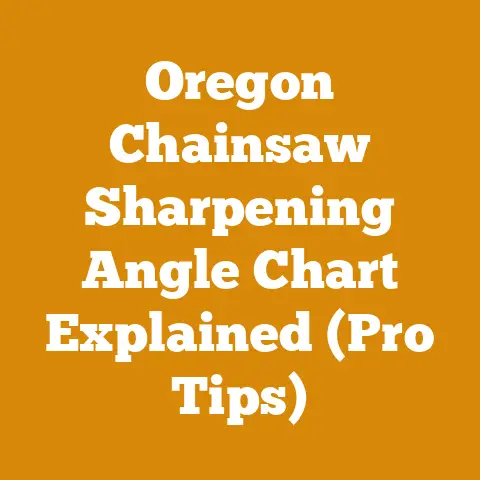3 Axle Flatbed Trailer Tips (5 Load Securing Secrets for Loggers)
Have you ever stood there, watching a loaded flatbed rumble down the road, and felt a knot of anxiety tighten in your stomach? I have. More than once. That feeling – the one that whispers, “Is that load secure?” – is a primal fear for anyone involved in logging and timber hauling. It’s a fear born from the understanding that a shifting load can mean disaster: injury, damage, or even worse. I’ve seen firsthand the aftermath of improperly secured logs, and believe me, it’s not a pretty sight. That’s why I’m dedicating this guide to mastering the art of securing logs on a 3-axle flatbed trailer.
This isn’t just about following regulations; it’s about ensuring the safety of yourself, your crew, and everyone else on the road. I’ll share my experiences, insights, and practical secrets I’ve learned over years in the logging industry. Let’s dive into the essential tips and techniques that will help you confidently secure your log loads every single time.
3-Axle Flatbed Trailer Tips: 5 Load Securing Secrets for Loggers
Understanding the Importance of Proper Load Securement
I’ve learned that proper load securement isn’t just a checkbox on a safety inspection; it’s a fundamental aspect of responsible logging. It directly impacts not only safety but also efficiency and profitability.
- Safety First: The primary reason is, of course, safety. A well-secured load prevents logs from shifting or falling off the trailer during transit. This protects you, your crew, other drivers, and pedestrians. I remember a time when a poorly secured log rolled off a truck ahead of me, narrowly missing my windshield. That incident reinforced the importance of meticulous securement.
- Preventing Damage: Shifting logs can damage the trailer itself, leading to costly repairs. I’ve seen damaged trailer beds, bent stakes, and broken tie-down equipment due to improper load securement.
- Legal Compliance: Regulations regarding load securement are strict and vary by jurisdiction. Non-compliance can result in hefty fines, penalties, and even the suspension of your logging operations.
- Efficiency and Profitability: Properly secured loads reduce the risk of delays caused by shifting loads, inspections, or accidents. This translates to more efficient operations and increased profitability.
Takeaway: Proper load securement is non-negotiable. It’s a critical investment in safety, compliance, and the long-term success of your logging operations.
Secret #1: Mastering the Art of Load Distribution
Load distribution is the foundation of a safe and stable log haul. An unevenly distributed load can compromise the trailer’s stability, making it more susceptible to swaying, tipping, or even jackknifing. I’ve experienced this firsthand when a load was too heavily weighted on one side, causing the trailer to lean precariously on a turn.
- The Center of Gravity: The goal is to keep the center of gravity as low and as close to the center of the trailer as possible. This maximizes stability and minimizes the risk of tipping.
- Weight Limits: Always adhere to the trailer’s weight limits and axle weight ratings. Overloading can compromise the trailer’s structural integrity and increase the risk of accidents. Consult your trailer’s specifications and local regulations for weight limits.
- Log Placement: Place the heaviest logs at the bottom and center of the load. This lowers the center of gravity and provides a stable base. Smaller, lighter logs can be placed on top and towards the sides.
- Even Distribution: Distribute the weight evenly across the trailer’s length and width. Avoid concentrating the weight in one area. Use a log scale and weight calculator to estimate the weight of each log and plan your load accordingly. I use a portable scale that I carry in my truck.
- Load Height: Keep the load as low as possible. A higher load increases the center of gravity and makes the trailer more susceptible to tipping.
Real-World Example: I once worked on a project where we were hauling large-diameter oak logs. We carefully planned the load, placing the largest logs in the center and using smaller logs to fill in the gaps. We also used load binders to compress the load and further lower the center of gravity. This resulted in a stable and secure load that transported safely without any issues.
Actionable Metric: Aim for a load distribution where the weight difference between the left and right sides of the trailer is no more than 5%. Regularly check your load distribution using a weigh scale and adjust as needed.
Takeaway: Load distribution is a critical skill that requires careful planning and execution. By understanding the principles of weight distribution and adhering to weight limits, you can ensure a stable and secure log haul.
Secret #2: Choosing the Right Tie-Down Equipment
The tie-down equipment is what physically secures the logs to the trailer. Using the wrong equipment or improperly maintaining it can lead to load failure. I’ve seen tie-down straps snap under pressure, chains loosen due to worn-out binders, and even entire loads shift because of inadequate securement.
- Types of Tie-Downs:
- Chains: Chains are the strongest and most durable type of tie-down. They are ideal for securing heavy logs and loads that are subject to high stress. I prefer using Grade 70 transport chains with a working load limit (WLL) that exceeds the weight of the logs they are securing.
- Straps: Straps are lighter and more flexible than chains. They are suitable for securing lighter loads and loads that require a more gentle touch. However, straps are more susceptible to wear and tear and should be inspected regularly.
- Wire Rope: Wire rope is a strong and reliable option for securing logs. It offers a good balance of strength and flexibility.
- Working Load Limit (WLL): The WLL is the maximum weight that a tie-down can safely secure. Always choose tie-downs with a WLL that exceeds the weight of the logs they are securing.
- Number of Tie-Downs: The number of tie-downs required depends on the weight and length of the logs being transported. Regulations typically require at least one tie-down for every 10 feet of log length, with a minimum of two tie-downs per load. Consult local regulations for specific requirements.
- Tie-Down Placement: Place tie-downs strategically to prevent the logs from shifting in any direction. Use a combination of direct tie-downs (which go directly from the log to the trailer) and indirect tie-downs (which go over the top of the load) to provide maximum securement.
- Inspection and Maintenance: Regularly inspect your tie-down equipment for signs of wear, damage, or corrosion. Replace any damaged or worn-out equipment immediately. Lubricate chains and binders to prevent rust and ensure smooth operation. I keep a detailed log of all inspections and maintenance performed on my tie-down equipment.
Case Study: A logging company I consulted with was experiencing frequent load shifts due to using undersized tie-down straps. After conducting a load securement audit, I recommended upgrading to chains with a higher WLL and implementing a regular inspection and maintenance program. This resulted in a significant reduction in load shifts and improved overall safety.
Actionable Metric: Implement a monthly inspection schedule for all tie-down equipment. Record the date of inspection, the condition of the equipment, and any maintenance performed. Replace any tie-downs that show signs of wear or damage.
Takeaway: Choosing the right tie-down equipment and properly maintaining it is essential for safe and secure log hauling. Invest in high-quality equipment and implement a regular inspection and maintenance program to ensure its reliability.
Secret #3: Mastering Tie-Down Techniques
Even with the best equipment, improper tie-down techniques can compromise load security. I’ve witnessed countless instances where tie-downs were improperly tightened, incorrectly positioned, or not used in accordance with regulations.
- Tightening Tie-Downs: Tighten tie-downs securely to prevent the logs from shifting. Use a load binder to tighten chains and a ratchet strap to tighten straps. Avoid overtightening, which can damage the tie-downs or the logs.
- Angle of Tie-Downs: The angle of the tie-downs is crucial for effective securement. Aim for an angle of 45 degrees or less between the tie-down and the trailer bed. This provides maximum holding power.
- Blocking and Bracing: Use blocking and bracing to prevent logs from shifting or rolling. Place blocks of wood or metal against the logs to prevent them from moving forward, backward, or sideways.
- Edge Protection: Use edge protection to prevent tie-downs from being cut or damaged by sharp edges on the logs. This can be as simple as placing a piece of wood or rubber between the tie-down and the log.
- Regular Checks: After the first few miles of travel, stop and check the tie-downs to ensure they are still tight. Logs can settle during transit, causing the tie-downs to loosen.
Personal Story: I once made the mistake of not checking my tie-downs after a short distance. As I rounded a bend, I heard a sickening sound and saw a log shift. Fortunately, I was able to pull over safely and re-secure the load before any serious damage occurred. That experience taught me the importance of regular tie-down checks.
Actionable Metric: Develop a checklist for tie-down procedures. Include steps for tightening, angle adjustment, blocking and bracing, and edge protection. Use this checklist every time you secure a load.
Takeaway: Mastering tie-down techniques requires practice and attention to detail. By following best practices and regularly checking your work, you can ensure that your log loads are securely fastened.
Secret #4: Understanding and Complying with Regulations
Load securement regulations are in place to protect everyone on the road. Ignoring or misunderstanding these regulations can lead to serious consequences. I’ve seen logging operations shut down for non-compliance, and I’ve personally received warnings for minor infractions.
- Federal Motor Carrier Safety Administration (FMCSA): The FMCSA sets the standards for load securement in the United States. Their regulations cover everything from the type of tie-downs required to the number of tie-downs needed for different types of loads.
- State Regulations: In addition to federal regulations, many states have their own load securement requirements. These regulations may be more stringent than the federal requirements.
- Industry Standards: Various industry organizations, such as the American Logging Council, have developed best practices for load securement. Following these best practices can help you ensure compliance and improve safety.
- Training: Ensure that all drivers and loaders are properly trained in load securement techniques and regulations. Regular training can help prevent accidents and ensure compliance.
- Documentation: Keep accurate records of all load securement inspections and maintenance. This documentation can be valuable in the event of an accident or inspection.
Original Insight: Many loggers are unaware of the specific regulations that apply to their operations. I recommend contacting your local Department of Transportation (DOT) or consulting with a load securement expert to ensure compliance.
Actionable Metric: Conduct a load securement audit to identify any areas where your operations may not be in compliance. Develop a plan to address any deficiencies and implement regular training for all employees.
Takeaway: Understanding and complying with load securement regulations is essential for responsible logging. Stay informed about the latest regulations, provide adequate training, and maintain accurate documentation to ensure compliance and avoid costly penalties.
Secret #5: The Power of Continuous Improvement
Load securement is not a static process. New technologies, regulations, and best practices are constantly emerging. A commitment to continuous improvement is essential for staying ahead of the curve and ensuring the safety and efficiency of your logging operations.
- Stay Informed: Subscribe to industry publications, attend workshops and conferences, and network with other loggers to stay informed about the latest developments in load securement.
- Embrace Technology: Explore new technologies that can improve load securement, such as electronic logging devices (ELDs) that monitor load weight and stability, and advanced tie-down systems that provide real-time tension monitoring.
- Learn from Mistakes: Analyze any load shifts or accidents to identify the root causes and implement corrective actions. Use these incidents as learning opportunities to prevent similar events from happening in the future.
- Seek Feedback: Solicit feedback from drivers, loaders, and other employees to identify areas where load securement practices can be improved.
- Regular Audits: Conduct regular load securement audits to assess the effectiveness of your procedures and identify any areas for improvement.
Expert Advice: Don’t be afraid to experiment with new techniques and technologies, but always do so in a controlled environment and with proper supervision.
Actionable Metric: Set aside time each month to research new load securement technologies and best practices. Attend at least one industry event per year focused on load securement.
Takeaway: Continuous improvement is the key to long-term success in load securement. By staying informed, embracing technology, learning from mistakes, seeking feedback, and conducting regular audits, you can ensure that your logging operations are always operating at the highest level of safety and efficiency.
Additional Tips for Securing Log Loads:
- Wood Species Considerations: Different wood species have different densities and weights. Adjust your load securement techniques accordingly. For example, hardwoods like oak and maple are denser and heavier than softwoods like pine and fir.
- Weather Conditions: Weather conditions can significantly impact load securement. In wet or icy conditions, logs can become slippery, making them more prone to shifting. Increase the number of tie-downs and use extra caution when securing loads in adverse weather.
- Road Conditions: Rough or uneven roads can also cause logs to shift. Slow down and drive carefully on rough roads. Regularly check your tie-downs to ensure they remain tight.
- Log Length and Diameter: Longer and larger diameter logs require more securement than shorter and smaller diameter logs. Use a sufficient number of tie-downs and ensure they are properly positioned to prevent shifting.
- Stakes and Bunking Systems: Ensure that the stakes and bunking systems on your trailer are in good condition and properly secured. These components provide additional support and prevent logs from rolling off the trailer.
Common Mistakes to Avoid:
- Using Undersized Tie-Downs: Always use tie-downs with a WLL that exceeds the weight of the logs they are securing.
- Improperly Tightening Tie-Downs: Tighten tie-downs securely to prevent the logs from shifting.
- Ignoring Edge Protection: Use edge protection to prevent tie-downs from being cut or damaged by sharp edges on the logs.
- Failing to Check Tie-Downs Regularly: Check tie-downs after the first few miles of travel and regularly throughout the trip.
- Overloading the Trailer: Always adhere to the trailer’s weight limits and axle weight ratings.
Final Thoughts
Securing log loads on a 3-axle flatbed trailer is a complex and demanding task. It requires a combination of knowledge, skill, and attention to detail. By mastering the secrets outlined in this guide, you can significantly improve the safety and efficiency of your logging operations.
Remember, load securement is not just a job; it’s a responsibility. It’s a responsibility to yourself, your crew, and everyone else on the road. Take it seriously, and always strive to do your best. The consequences of failure can be devastating.
I hope this guide has been helpful. I encourage you to share it with your colleagues and use it as a resource for improving load securement practices in your logging operations. Stay safe out there!






